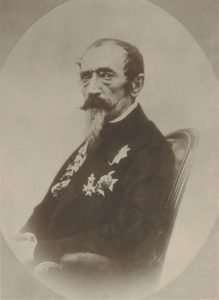 On this day in 1863 painter Horace Vernet died in Paris at the age of 73. Born Émile Jean-Horace Vernet on 30 June 1789 in the Louvre in Paris. Vernet’s father Carle Vernet and grandfather Claude Joseph Vernet were painters.
On this day in 1863 painter Horace Vernet died in Paris at the age of 73. Born Émile Jean-Horace Vernet on 30 June 1789 in the Louvre in Paris. Vernet’s father Carle Vernet and grandfather Claude Joseph Vernet were painters.
He was born in the Paris Louvre, while his parents were staying there during the French Revolution. Vernet decided to paint subjects taken mostly from contemporary life. He gained recognition during the Bourbon Restoration for a series of battle paintings commissioned by the duc d’Orleans, the future King Louis-Philippe. Enjoying equal favour with the court and with the opposition, he was appointed director of the French Academy in Rome, from 1829 to 1835.
The King requested that he paint a gallery dedicated to the “fruits of colonization”. At the time, France was colonizing Algeria through war, and claiming it to be part of their mission civilsatrice, or their “civilizing mission”. In a neoclassical style, reflecting the Roman colonization in North Africa about 2000 years before, Horace painted stills of French non-commissioned officers training Algerian soldiers, French engineers building Algerian roads, and French soldiers tilling Algerian fields.
His depictions of Algerian battles, such as the Capture of the Smahla and the Capture of Constantine, were well-received by other French people, as they were vivid depictions of their army in the heat of battle. After the fall of the July Monarchy during the Revolution of 1848, Vernet discovered a new patron in Napoléon III of France. He accompanied the French Army during the Crimean War, producing several paintings. One well known and possibly apocryphal anecdote maintains that when Vernet was asked to remove a certain obnoxious general from one of his paintings, he replied, “I am a painter of history, sire, and I will not violate the truth,” hence demonstrating his fidelity to representing war.
Vernet also developed an interest in daguerreotype photography. He took photographs in Egypt as reference material for his paintings, and during a stop at Malta in March 1840 while en route to Egypt, he took the earliest known photographs of the island at Fort Manoel. Today these early photographs are believed to be lost.
In Arthur Conan Doyle’s Sherlock Holmes story “The Adventure of the Greek Interpreter” Holmes claims to be related to Vernet, stating, “My ancestors were country squires… my grandmother… was the sister of Vernet, the French artist.”, without further clarifying which Vernet.
Gallery
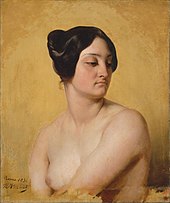
Olympe Pélissier, étude pour Judith et Holopherne (1830), musée des Beaux-Arts de Boston.
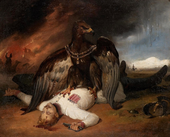
Allégorie de la Pologne vaincue ou Le Prométhée polonais (vers 1831), Bibliothèque polonaise de Paris6.
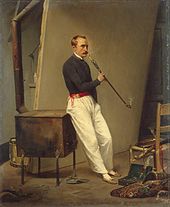
Autoportrait (1835), Saint-Pétersbourg, musée de l’Ermitage.
- Œuvres d’Horace Vernet
-

La Barrière de Clichy. Défense de Paris, le (1820), Paris, musée du Louvre.
-

Allan M’Aulay (1823), Londres, Wallace Collection.
-

Mazeppa et les loups (1826), Avignon, musée Calvet.
-

Scène Berbère (1833), cabinet des estampes et des dessins de Strasbourg.
-

Chasse au sanglier (vers 1835), cabinet des estampes et des dessins de Strasbourg.
-

La Bataille d’Iéna, (1836), Versailles, musée de l’Histoire de France.
-

La Retraite (Cavalier arabe) (1839).
-

Juda et Tamar (1840), Londres, Wallace Collection.
-

Barricade dans la rue de Soufflot, à Paris, le (vers 1848-1849), Berlin, musée historique allemand
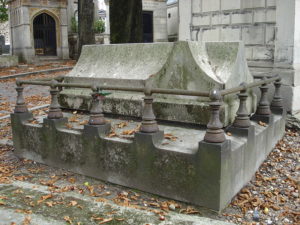 The Final Footprint
The Final Footprint
Vernet is entombed in cimetière de Montmartre in Paris. Other notable final footprints at Montmartre include; Hector Berlioz, Dalida, Edgar Degas, Alexandre Dumas, fils, Marie Duplessis, France Gall, Théophile Gautier, Gustave Moreau, Jeanne Moreau, Henri Murger, Jacques Offenbach, Stendhal, François Truffaut, and Alfred de Vigny.
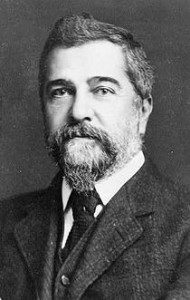 On this day in 1933, artist and designer Louis Comfort Tiffany died in New York City at the age of 84. Born on 18 February 1848 in New York City, the son of Charles Lewis Tiffany, founder of Tiffany and Company; and Harriet Olivia Avery Young. Tiffany worked in the decorative arts and is best known for his work in stained glass. He is the American artist most associated with the Art Nouveau and Aesthetic movements. Tiffany was affiliated with a prestigious collaborative of designers known as the Associated Artists. Tiffany designed stained glass windows and lamps, glass mosaics, blown glass, ceramics, jewelry, enamels and metalwork. Tiffany married twice: Mary Woodbridge Goddard (1872 – 1884 her death) and Louise Wakeman Knox (1886 – 1904 her death).
On this day in 1933, artist and designer Louis Comfort Tiffany died in New York City at the age of 84. Born on 18 February 1848 in New York City, the son of Charles Lewis Tiffany, founder of Tiffany and Company; and Harriet Olivia Avery Young. Tiffany worked in the decorative arts and is best known for his work in stained glass. He is the American artist most associated with the Art Nouveau and Aesthetic movements. Tiffany was affiliated with a prestigious collaborative of designers known as the Associated Artists. Tiffany designed stained glass windows and lamps, glass mosaics, blown glass, ceramics, jewelry, enamels and metalwork. Tiffany married twice: Mary Woodbridge Goddard (1872 – 1884 her death) and Louise Wakeman Knox (1886 – 1904 her death).
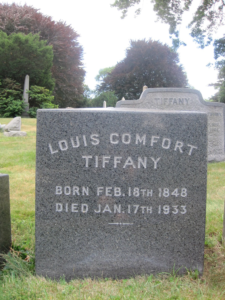 The Final Footprint – Tiffany is interred in Green-Wood Cemetery, Brooklyn. Other notable final footprints at Green-Wood include; Albert Anastasia, Jean-Michel Basquiat, Leonard Bernstein, Lorenzo da Ponte, and Charles Ebbes.
The Final Footprint – Tiffany is interred in Green-Wood Cemetery, Brooklyn. Other notable final footprints at Green-Wood include; Albert Anastasia, Jean-Michel Basquiat, Leonard Bernstein, Lorenzo da Ponte, and Charles Ebbes.
Gallery
-
- Stained glass windows
-
-

Window of St. Augustine, in the Lightner Museum, St. Augustine, Florida.
-
-
-
Girl with Cherry Blossoms (c. 1890)
-
-
-
The Tree of Life stained glass
-
-
-

Angel of the Resurrection (1904), in the Indianapolis Museum of Art
-
-
-

The New Creation, at Brown Memorial Presbyterian Church, Baltimore, Maryland
-
-
-
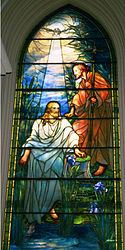
The Baptism of Christ, at Brown Memorial
-
-
-

Nicodemus Came to Him by Night, First Presbyterian Church, Lockport, NY
-
-
-
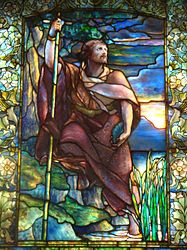
John the Baptist at Arlington Street Church in Boston
-
-
-
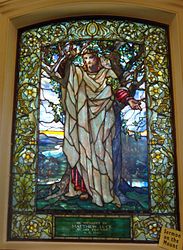
Sermon on the Mount at Arlington Street Church in Boston
-
-
-
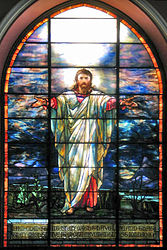
Christ the Consoler at Pullman Memorial Universalist Church, Albion, NY
-
-

Pastoral window at Second Presbyterian Church (Chicago, Illinois)
-
Education (Chittenden Memorial Window) at Yale University
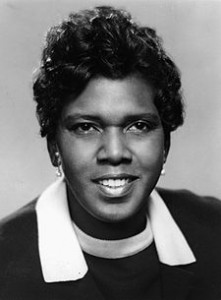 On this day in 1996, U.S. Congresswoman, Texas Senator, Presidential Medal of Freedom recipient, Barbara Jordan, died in Austin, Texas. Born Barbara Charline Jordan on 21 February 1936 in Houston, Texas. She was the first African-American elected to the Texas Senate after reconstruction and the first Southern black woman ever elected to the U.S. House of Representatives. Jordan was mentioned as a possible running mate to Jimmy Carter in 1976. That year, she became the first African-American woman to deliver the keynote address at the Democratic National Convention. Jordan retired from politics in 1979 and became an adjunct professor teaching ethics at the University of Texas at Austin Lyndon B. Johnson School of Public Affairs.
On this day in 1996, U.S. Congresswoman, Texas Senator, Presidential Medal of Freedom recipient, Barbara Jordan, died in Austin, Texas. Born Barbara Charline Jordan on 21 February 1936 in Houston, Texas. She was the first African-American elected to the Texas Senate after reconstruction and the first Southern black woman ever elected to the U.S. House of Representatives. Jordan was mentioned as a possible running mate to Jimmy Carter in 1976. That year, she became the first African-American woman to deliver the keynote address at the Democratic National Convention. Jordan retired from politics in 1979 and became an adjunct professor teaching ethics at the University of Texas at Austin Lyndon B. Johnson School of Public Affairs.
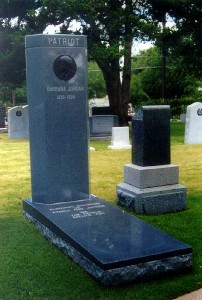 The Final Footprint – Jordan is interred in the Texas State Cemetery in Austin becoming the first African-American woman interred there. Her grave is marked by a large granite upright column monument and a full ledger granite marker. At the top of the column the word, PATRIOT, is engraved and the ledger is engraved in part; WE THE PEOPLE SALUTE YOU. Upon her death, Jordan lay in state at the LBJ Library on the campus of The University of Texas at Austin. The main terminal at Austin-Bergstrom International Airport is named after her. On April 24, 2009, a Barbara Jordan statue was unveiled at the University of Texas at Austin. Other notable final footprints at Texas State Cemetery include; Stephen F. Austin, John B. Connally, Nellie Connally, J. Frank Dobie, Tom Landry (cenotaph), James A. Michener (cenotaph), Ann Richards, Edwin “Bud” Shrake, Big Foot Wallace, and Walter Prescott Webb.
The Final Footprint – Jordan is interred in the Texas State Cemetery in Austin becoming the first African-American woman interred there. Her grave is marked by a large granite upright column monument and a full ledger granite marker. At the top of the column the word, PATRIOT, is engraved and the ledger is engraved in part; WE THE PEOPLE SALUTE YOU. Upon her death, Jordan lay in state at the LBJ Library on the campus of The University of Texas at Austin. The main terminal at Austin-Bergstrom International Airport is named after her. On April 24, 2009, a Barbara Jordan statue was unveiled at the University of Texas at Austin. Other notable final footprints at Texas State Cemetery include; Stephen F. Austin, John B. Connally, Nellie Connally, J. Frank Dobie, Tom Landry (cenotaph), James A. Michener (cenotaph), Ann Richards, Edwin “Bud” Shrake, Big Foot Wallace, and Walter Prescott Webb.
#RIP #OTD in 2010 author (Love Story, Oliver’s Story), screenwriter, educator, and classicist Erich Segal, who had Parkinson’s disease, died of a heart attack in London, aged 72. Hoop Lane Jewish Cemetery, Golders Green, London.
Have you planned yours yet?





COOL INFO IM DOING A PROJECT ON HER